Brazilian Jiu Jitsu is considered one of the most effective martial arts. However, getting a Black Belt in BJJ is super hard and takes years of training, as the learning curve is very challenging. Despite being popular these days, people still have doubts about Jiu-Jitsu. A question that beginners always ask is the following: what is the order of belts in Brazilian Jiu Jitsu?
The order of belts in Brazilian Jiu Jitsu is divided into two age groups: from 4 to 15 years old the order is White, Grey, Yellow, Orange, and Green (with white and black stripes in between). From 16+ is a different order: White, Blue, Purple, Brown, Black, Red and Black, Red and White, Red Belt.
Brazilian Jiu-Jitsu Belts System
What we know now as Brazilian Jiu Jitsu is way different than the early days of this martial art in its birthplace, Brazil, in the past century. That’s expected. Both technical and philosophical aspects of the fight evolved over the years, especially after the early days of UFC. Also, competitive BJJ started to be mainstream and these days there are great events happening pretty much every month. To organize all of these concepts and competitions, federations emerged with rules that need to be followed to standardize the BJJ around the world. One of these aspects is the belt system.
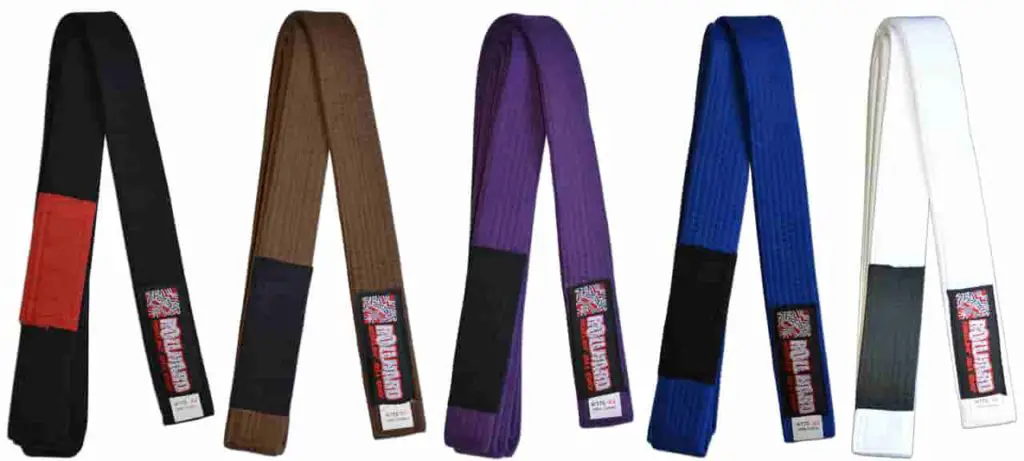
The most important federation in the sports of BJJ is the IBJJF (International Brazilian Jiu-Jitsu Federation), and their Graduation System was created to unify and standardize the teachings, practice, and competition of modern Jiu-Jitsu. It’s the best way to understand the belts in Brazilian Jiu-Jitsu. The Brazilian Jiu-Jitsu belt system is easy to understand, but hard to graduate on. Getting a Black Belt can be a lifetime journey for some people. At the very least, it’ll take 6 years, but the average is 10+ (and this is not even the last belt). As said before, in BJJ there are two different age groups with different belts, but the starting point is always the same: the White belt. To understand it all in detail, read on.
BJJ Belts System For Ages 4 to 15
This belt system is focused on the first steps of kids in BJJ. The rankings focus on teaching Jiu-Jitsu but are not limited to that, as kids can (and need) develop skills and abilities for their lives by training. So the methods of evaluation are not the same for the adults (16+), with different belt colors. The following image shows the 13 Brazilian Jiu Jitsu belts order for athletes from 4 to 15 years old.
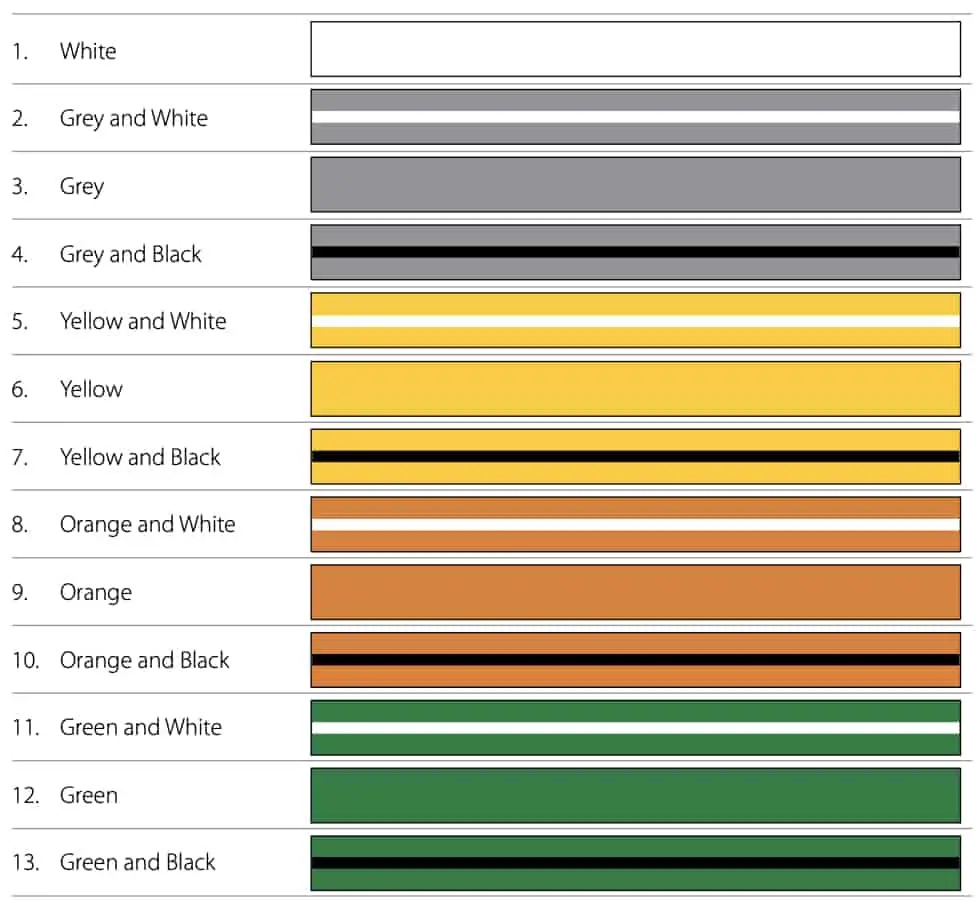
It’s important to notice that there is no minimum age to start training BJJ. However, to graduate to the first belt rank Grey and White (Grey Group), the student needs to be at least 4 years old. Each group of ranks has a minimum and maximum age. In this category, for all groups, the maximum age is 15 years, because the belt ranks are different for athletes ages 16 years and older.
| Rank Group | Belts/Ranks In Group | Minimum Age (For Any Belt In Group) |
| White | White Belt | Any Age |
| Grey | Grey and White, Grey, Grey and Black | 4 to 15 years |
| Yellow | Yellow and White, Yellow, Yellow and Black | 7 to 15 years |
| Orange | Orange and White, Orange, Orange and Black | 10 to 15 years |
| Green | Green and White, Green, Green and Black | 13 to 15 years |
Another important thing to know about this subject is the fact that the minimum age for the athlete to be eligible to receive a new belt is the age he or she has completed or will complete in the current year, following the formula: CURRENT YEAR – BIRTH YEAR = AGE OF THE ATHLETE (for graduation matters).
Finally, in the year that the athlete turns 16 years of age, he or she must be placed in the belt system described in the next section. The student will be promoted to the new rank according to the belt he has:
- White Belt – Remains in White Belt;
- Grey Belt, Yellow Belt, Orange Belt – turns to Blue Belt;
- Green Belt – turns Blue or Purple Belt according to professor’s decision.
BJJ Belts System For Ages 16+
If you started training after 16 years old or if you’re used to watching adult competitions, this is the order of belts in Brazilian Jiu Jitsu that you are used to seeing. As the minimum age to graduate to a Blue Belt in BJJ is 16, this is the system where is more usual to see professional athletes and MMA fighters ranked on. These rules are also defined by the IBJJF. There are 8 belts, with the last one being reserved for the grandmasters of the martial art.
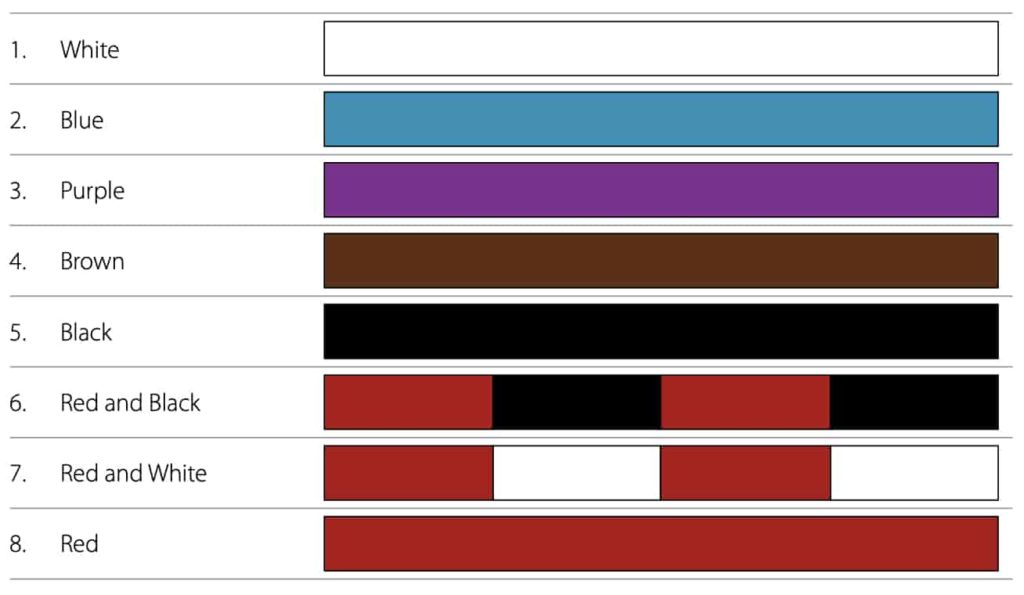
In addition to the 16+ requirement to graduate to the Blue Belt, there are other different criteria involving age and minimum time needed in each belt. To IBJJF, the minimum age for the athlete to be eligible to change belt is the age he or she has completed or will complete in the current year, following the same formula describe before: CURRENT YEAR – BIRTH YEAR = AGE OF THE ATHLETE. The minimum time to be respected in each belt is described in the following table.
| Belt | Minimum Age | Minimum Period (16 to 17 years) | Minimum Period (18 years +) |
| White | Any Age | No Minimum Time | No Minimum Time |
| Blue | 16 years + | No Minimum Time | 2 years |
| Purple | 16 years + | 2 years | 1 year and a half |
| Brown | 18 years + | 1 year | 1 year |
| Black | 19 years + | 31 years | 31 years |
| Red and Black | – | 7 years | 7 years |
| Red and White | – | 10 years | 10 years |
| Red | – | – | – |
There’s only one detail that differs for students between 16 and 17 years: for them, there’s no minimum time in the blue belt, however, they need to stay at least 2 years in the purple rank. From then on, it follows the same rules for 18 years or more. The time it takes for the athlete to graduate from white belt to black belt is up to the athlete’s professor. However, the IBJJF requires a mandatory minimum amount of time the athlete must spend at each belt level. From the black belt graduation on (red and black belt, red and white belt, and red belt) the practitioner must meet the mandatory minimum time requirement for each belt rank after the black belt graduation date.
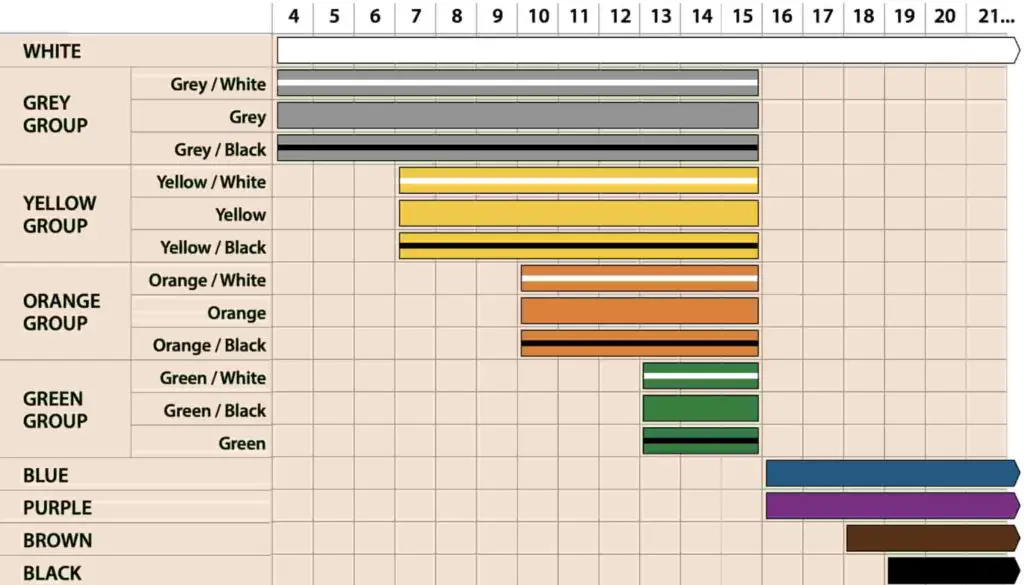
BJJ Belts Guide: Details and Configuration
The International Brazilian Jiu-Jitsu Federation has rules for the belts configurations as well. There are specific types and dimensions of Belts for the ages 04 to 16, then from the White to the Brown Belt, to the Black Belt, to the Red and Black Belt, and also to the Red and White Belt. Finally, there is a unique configuration for the Red Belt (Grand Master’s Belt).
Athletes From 4 to 15 Years Old
That’s the starting point in BJJ ranks for kids. There’s no minimum age to start training Brazilian Jiu-Jitsu, but to receive the first belt, the student needs to be, at the very least, 4 years old. This range of rankings for kids includes athletes from 4 to 15 years old. The configuration of all belts in this range is the same, the only thing that will vary is the color. According to the IBJJF rules, “belts will have from 2.5 cm (0.98 in) to 3.5 cm (1.38 in) wide and one black bar of approximately 10 cm (3.94 in) in length positioned between 2 cm (0.79 in) to 3 cm (1.18 in) in one of the ends. The belt may have only the color of the group or a white or black stripe in the center along its entire length.”
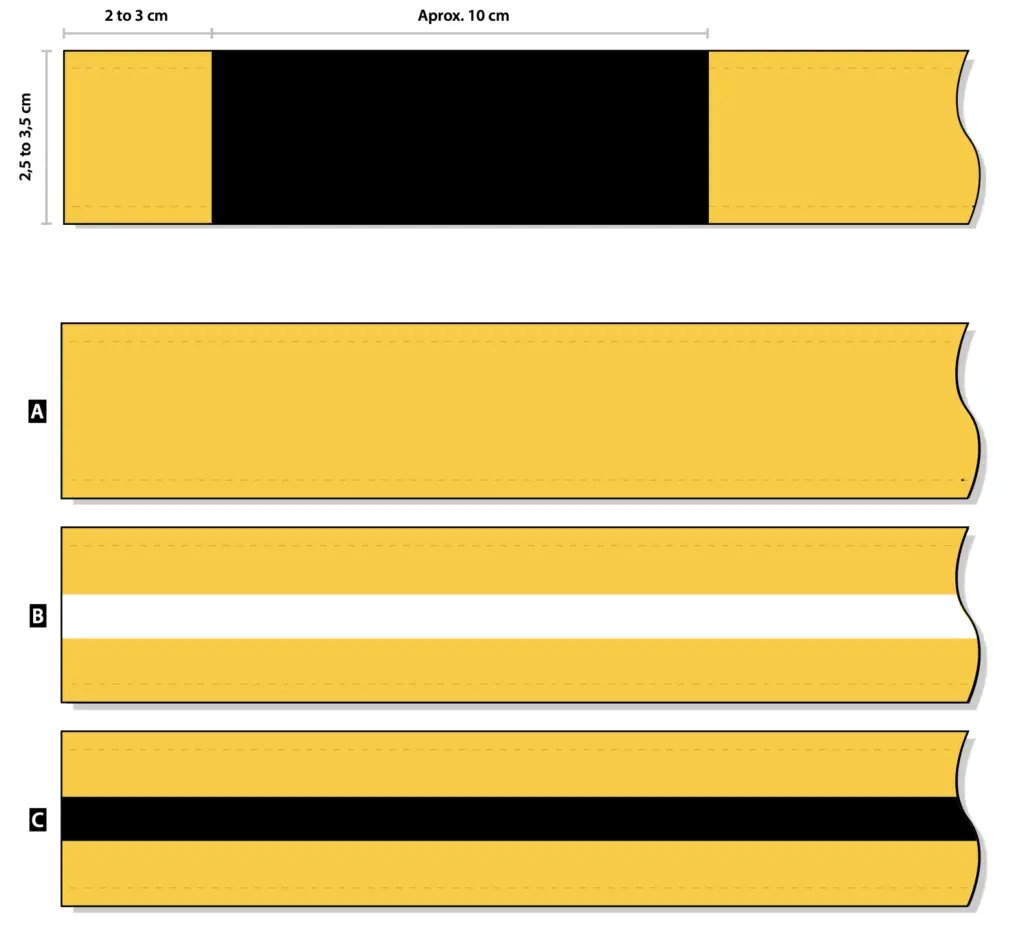
White Belt to Brown Belt (Age 16+)
According to the rules described in its guide, IBJJF says that the belt dimensions and specifications from the White to the Brown rank are the following: “Belts will have from 3.5 cm (1.38 in) to 4.5 cm (1.77 in) wide; a black bar of approximately 10 cm (3.94 in) length placed between 2 cm (0.79 in) to 3 cm (1.18 in) in one of the ends.” Usually, if you’re starting after 16, that’s the kind of belt you’re going to use.

Black Belt
As shown in the IBJJF Graduation System PDF report, the Black belt will have a red bar of approximately 10 cm (3.94 in) in length positioned between 2 cm (0.79 in) to 3 cm (1.18 in) in one of the ends. It will be delineated by two white bars and will receive markings from one to six degrees. Receiving a BJJ Black belt rank in a real deal school is hard, but super satisfying.

Coral Belts (Red and Black Belt / Red and White Belt)
Getting a Black Belt in BJJ is hard enough, but if you keep training for 31 years after graduation, you’ll be considered a Master at Jiu-Jitsu and receive a Coral Belt. As shown in the IBJJF guide, the Coral Belts (common name in Brazil) or Master’s Belts are Red and Black (7th grade) and Red and White (8th grade) intercalated with stripes of 20 cm (7.87 in). The belts will have a white bar of approximately 15 cm (5.91 in) length placed between 2 (0.79 in) to 3 cm (1.18 in) in one of the ends delineated by two silver bars in which will receive degrees’ markings in red.
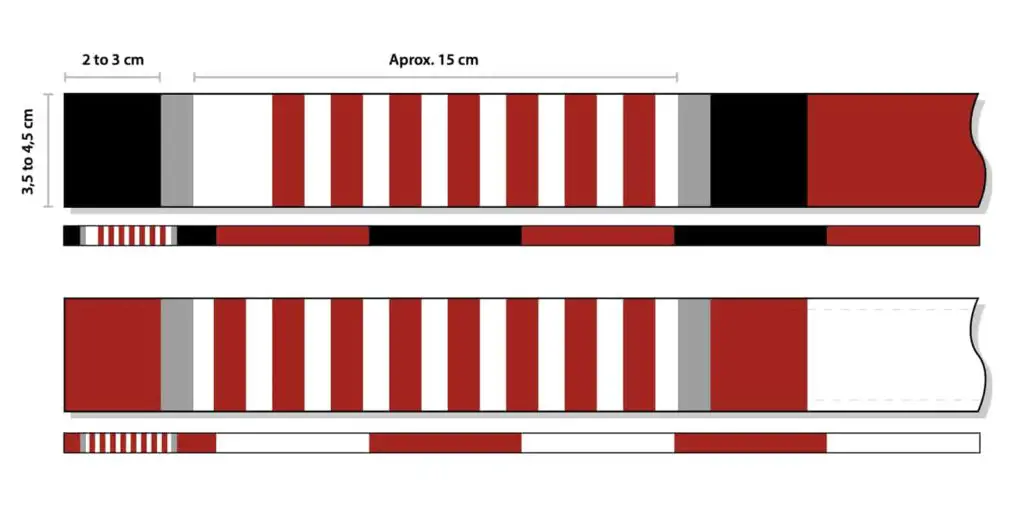
Red Belt (Grand Master’s Belt)
According to Renzo and Royler Gracie, important members of the Gracie Family (Brazilian Jiu-Jitsu Founders), in BJJ the Red Belt is reserved “for those whose influence and fame takes them to the pinnacle of art”. And it’s a journey that takes a lifetime of dedication. For example, if a BJJ athlete receives a black belt at 19 years old, the earliest they could expect to receive a red belt would be at the age of 67. According to the IBJJF rules, the Grand Master’s belt will be red. Plus, “It will have a white bar of approximately 15 cm (5.91 in) length placed between 2 cm (0.79 in) to 3 cm (1.18 in) in one of the ends delineated by two gold bars of 2 cm (0.79 in) which will receive degrees’ markings in red.”

Check Also: Does Brazilian Jiu Jitsu Have Belts?
Related Questions
What is the Jiu Jitsu belt color order? The belt color order in Jiu Jitsu for adults (16+) is White, Blue, Purple, Brown, Black, Red and Black, Red and White, Red (the last rank). From 4 to 15 years old, the order is different, with 13 belts: starting from the White to the Green and Black belt.
How many belts are there in Brazilian jiu-jitsu? There are 8 belts in Brazilian jiu-jitsu for adults (16+), being them: white, blue, purple, brown, black, red and black, red and white, and red. For kids, there are 13 belts, that go from the first (White) to the last one (Green and Black).
What belt do you start with in BJJ? The White Belt is the rank you start in within BJJ. There are two belt systems in Jiu-Jitsu, divided by age groups. For adults, there are 8 belt ranks, from White to Red. For kids, from 4 to 15 years old, there are 13 belt ranks, from White to Green and Black.
